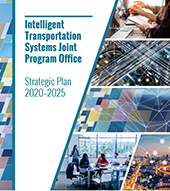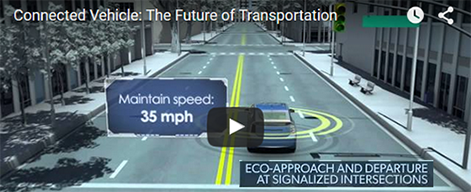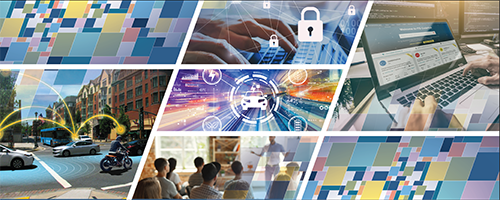News & Information
What Public Officials Need to Know About Connected Vehicles
Connected vehicles have the potential to transform the way Americans travel through the creation of a safe, interoperable wireless communications network—a system that includes cars, buses, trucks, trains, traffic signals, cell phones, and other devices. In the past, the U.S. Department of Transportation (USDOT) has focused on helping people survive crashes. Connected vehicle technology will change that paradigm by giving people the tools to avoid crashes. Connected vehicles can help drivers anticipate potential crashes and significantly reduce the number of lives lost each year.
What Are Connected Vehicles and How Do They Work
Connected vehicle technology can change our transportation system as we know it by enabling safe, interoperable networked wireless communications among vehicles, the infrastructure, and passengers’ personal communications devices. Connected vehicle technology will enable cars, trucks, buses, and other vehicles to “talk” to each other with in-vehicle or aftermarket devices that continuously share important safety and mobility information. Connected vehicles can also use wireless communication to “talk” to traffic signals, work zones, toll booths, school zones, and other types of infrastructure.
Different communications technologies (satellite, cellular, dedicated short-range communications) may be utilized depending on the performance requirements of the connected vehicle applications. Cars, trucks, buses, and other vehicles can “talk” to each other with in-vehicle or aftermarket devices that continuously share important safety and mobility information. Connected vehicles can also use wireless communication to “talk” to traffic signals, work zones, toll booths, school zones, and other types of infrastructure. The vehicle information communicated does not identify the driver or vehicle, and technical controls have been put in place to help prevent vehicle tracking and tampering with the system.
The vision for connected vehicle technologies is to transform surface transportation systems to create a future where:
- Highway crashes and their tragic consequences are significantly reduced
- Traffic managers have data to accurately assess transportation system performance and actively manage the system in real time, for optimal performance
- Travelers have continual access to accurate travel time information about mode choice and route options, and the potential environmental impacts of their choices
- Vehicles can talk to traffic signals to eliminate unnecessary stops and help drivers operate vehicles for optimal fuel efficiency.
Like the Internet, which provides information connectivity, connected vehicle technology provides a starting point for transportation connectivity that will potentially enable countless applications and spawn new industries.
Connected Vehicles Can Make It Easier to Travel in Your Community
According to the Texas Transportation Institute, U.S. highway users wasted 6.9 billion hours stuck in traffic in 2014. While the primary goal is safety, connected vehicle communications are also significant in improving mobility and environment by reducing delays and congestion caused by crashes, enabling wireless roadside inspections, or helping commercial vehicle drivers identify safe areas for parking.
Connected vehicles transmit anonymous signals that will help generate new data about how, when, and where vehicles travel—information that transportation managers will then analyze to help make roads safer and less congested. The same signals could also be shared among mobile devices and roadside sensors. Connected vehicles also include buses, trains, and other forms of public transit. So, by providing real-time information, travelers will have a realistic idea of when transit vehicles will arrive. They will also be able to improve bus and train connections, and this will help make public transportation more appealing to the average traveler.
Connected Vehicles Can Make Your Communities More Livable
One of the principles of livability is to provide more transportation choices to decrease household transportation costs, reduce our dependence on oil, improve air quality, and promote public health. Connected vehicles can help to make our communities more livable by providing a new data-rich environment that will spawn a multitude of new applications to keep traffic flowing and make it easier for people to plan their travel experience. Imagine, for instance, applications that can help you find open parking spaces, locate available taxis, guarantee you make your bus or train connection, or help a blind pedestrian cross the street. Connected vehicles can also support livability by providing pedestrians with additional information about road and sidewalk conditions before they leave home; giving public buses priority when they approach red lights so that transit travelers are less likely to be stuck in traffic; helping travelers choose the greenest transportation route and minimize the amount of time they are in their cars; and allowing local communities to set up comprehensive wirelessbased transportation management centers that will help them much better manager an interconnected network that includes all local modes of transportation.
Connected Vehicles Are Closer Than You Think
The reality of a nationwide network of connected vehicles is closer than once thought possible. The reality of a nationwide network of connected vehicles is closer than once thought possible. The USDOT is pursuing a robust Connected Vehicle Pilot Deployment Program to expedite the implementation of connected vehicle technology. The USDOT has awarded up to $45 million to New York City; Tampa, FL; and Wyoming for the pilots.
These three sites are deploying, testing, and operationalizing innovative technologies and applications to help drivers better use the roadways, relieve stress caused by bottlenecks, and increase pedestrian safety. From September 2015 to September 2016, each site prepared a comprehensive deployment concept to ensure a rapid and efficient connected vehicle capability roll-out. Since 2016, the sites have worked to design, build, and test these deployments of integrated wireless in-vehicle, mobile device, and roadside technologies. Now, the sites are preparing to enter the operational phase, in which the tested system will be placed into operational practice, maintained in good working order, and monitored on a set of key performance metrics to measure its impact.
Connected Vehicles Can Dramatically Reduce Crashes in Your Community
According to the National Highway Traffic Safety Administration (NHTSA), there were 7.2 million crashes and 3.14 million people were injured in 2016. The number of fatalities from vehicle crashes is falling but still accounted for 37,461 people killed in 2017. A recent NHTSA report found that wireless vehicle-tovehicle (V2V) and vehicle-to-infrastructure (V2I) communications has the potential to address crash scenarios involving nonimpaired drivers. In part, this is because connected vehicles feature safety warnings that alert drivers of potentially dangerous situations—impending collisions, icy roads, and dangerous curves—before the driver is aware of them.
By exchanging anonymous, vehicle-based data regarding position, speed, and location (at a minimum), V2V communications enables a vehicle to sense threats and hazards with a 360-degree awareness of the position of other vehicles and the threat or hazard they present; calculate risk; issue driver advisories or warnings; or take pre-emptive actions to avoid and mitigate crashes. Pivotal work is being conducted to guarantee that these driver warnings will not be a distraction and that people will only be made aware when they are approaching danger.
Connected Vehicles Can Make Your Communities Safer
Through V2I communications, connected vehicles can wirelessly exchange critical safety and operational data between vehicles and highway infrastructure to avoid or mitigate motor vehicle crashes, as well as enable a wide range of other safety, mobility, and environmental benefits that will help to make our roads and communities safer. V2I communications apply to all vehicle types and all roads and transform infrastructure equipment into “smart infrastructure” that can recognize high-risk situations in advance, resulting in driver alerts and warnings through specific countermeasures. By communicating with roadside infrastructure, connected vehicles can alert drivers when they are entering a school zone, if workers are on the side of the road, and if an upcoming traffic light is about to change. V2I communications have the potential to resolve an additional 12 percent of crash types not addressed under V2V communications.
Connected Vehicles Can Help Curb Local Pollution
According to the Texas Transportation Institute, the total amount of wasted fuel topped 3.1 billion gallons in 2014. In addition, the transportation sector contributes 28.5 percent of U.S. greenhouse gas emissions in 2016, according to the Environmental Protection Agency’s Inventory of U.S. Greenhouse Gas Emissions and Sinks. Connected vehicle technologies will generate real-time data that drivers and transportation managers can use to make green transportation choices.
One example is how real-time information about traffic conditions will help motorists eliminate unnecessary stops and let their vehicles reach optimal fuel-efficiency. Informed travelers may also be able to avoid congestion by taking alternate routes or public transit, or rescheduling their trip— any of which can make their trip more eco-friendly. Data generated from connected vehicle systems can also provide operators with detailed, real-time information on vehicle location, speed, and other operating conditions. This information can be used to improve system operation. On-board equipment may also advise vehicle owners on how to optimize the vehicle’s operation and maintenance for maximum fuel efficiency.
The U.S. Government’s Role
USDOT’s Intelligent Transportation Systems Joint Program Office fosters the development and future deployment of these connected vehicle technologies. But connected vehicle research involves several agencies within the USDOT, including NHTSA, the Federal Highway Administration, the Federal Motor Carrier Safety Administration, the Federal Transit Administration, and the Federal Railroad Administration.
The USDOT and its public and private partners are working to address the technical, safety, and policy challenges and are helping to create the standards and the wireless architecture that will be the backbone of the system
Connected vehicle research will leverage the potentially transformative capabilities of wireless technology to make surface transportation safer, smarter, and greener. If successful, connected vehicles will ultimately enhance the mobility and quality of life of all Americans, while helping to reduce the environmental impact of surface transportation.
Connected vehicle applications provide connectivity between and among vehicles, infrastructure, and wireless devices to:
- Enable crash prevention
- Enable safety, mobility and environmental benefits
- Provide continuous real-time connectivity to all system users
Motor vehicle crashes were the leading cause of death for ages 11 and 16 to 24, according to the Centers for Disease Control.
Agencies involved in connected vehicle research:
- Federal Highway Administration (FHWA)
- Federal Motor Carrier Safety Administration (FMCSA)
- Federal Railroad Administration (FRA)
- Federal Transit Administration (FTA)
- Maritime Administration (MARAD)
- National Highway Traffic Safety Administration (NHTSA)
- Office of the Assistant Secretary for Research and Technology
For more information about this initiative, please contact:
Mike Pina
Program Manager, Communications and Outreach
ITS Joint Program Office
(202) 366-3700
Mike.Pina@dot.gov










